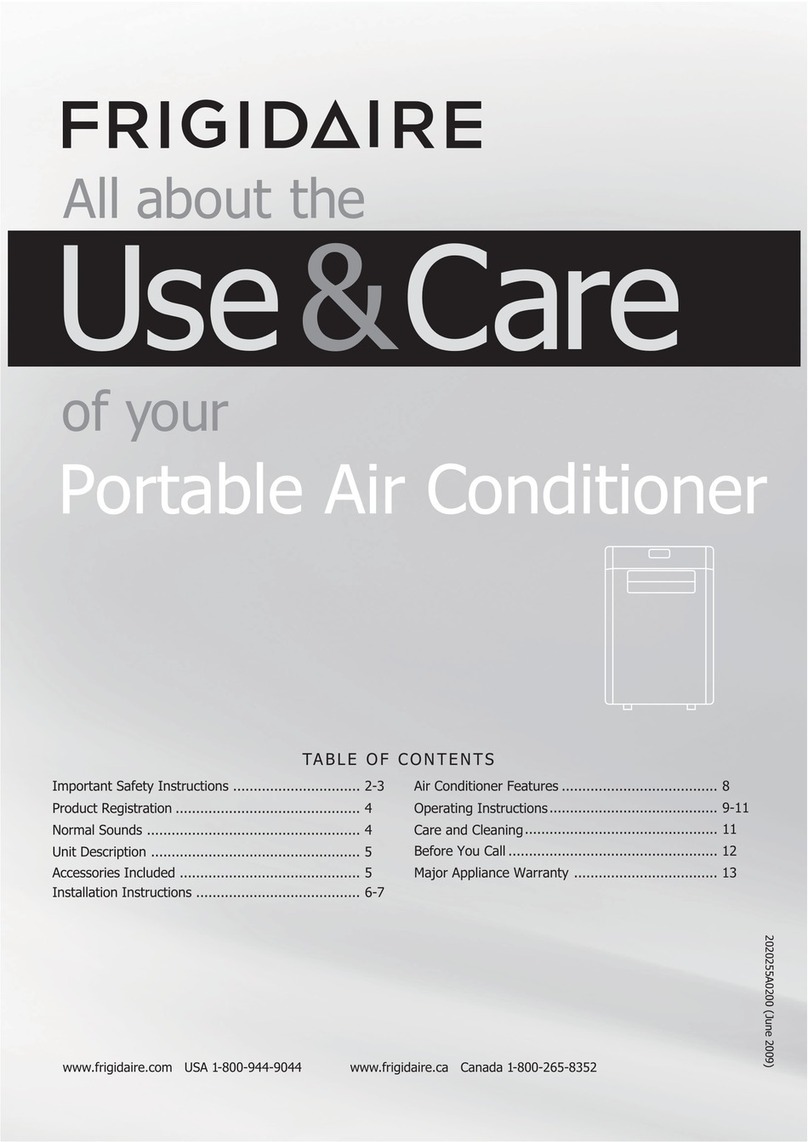
2
SECTION 1. OWNER INFORMATION
Your heat pump will heat and cool your home
year round, saving your energy dollars.During the
summer, a heat pump performs like any normal
air conditioner. That is, the excess heat energy
inside the home is absorbed by the refrigerant
and exhausted outside the home. During the
winter months, a heat pump performs like an
air conditioner run in reverse. That is, available
heat energy outside the home is absorbed by
the refrigerant and exhausted inside the home.
This is an efficient heating means because you
only pay for “moving” the heat from the outdoors
to the indoor area. You do not pay to generate
the heat, as is the case with more traditional
furnace designs.
It is the sole responsibility of the homeowner
to make certain that the heat pump has been
correctly set up and adjusted to operate
properly.
A warranty certificate with full details is included
with the heat pump. However, the manufacturer
will not be responsible for any costs found neces-
sary to correct problems due to improper setup,
improper installation, adjustments, improper op-
erating procedure on the part of the user, etc.
Some specific examples of service calls which
are not included in the limited warranty are:
1. Correcting wiring problems in the electrical
circuit supplying the heat pump.
2. Resetting circuit breakers or other switches.
3. Adjusting or calibrating of thermostat.
To avoid misunderstandings at a later date,
carefully review these responsibilities with your
dealer or service company.
OPERATING INSTRUCTIONS
To Operate Your Heat Pump For Cooling —
1. Set the thermostat system switch to COOL
and the thermostat fan switch to AUTO. (See
Figure 1)
2. Set the thermostat temperature selector to the
desired cooling temperature.The outdoor unit
fan, the indoor blower, and the compressor
will all cycle on and off to maintain the indoor
temperature at the desired cooling level.
NOTE: If the thermostat temperature level is
re-adjusted, or if the thermostat system switch
is re-positioned, the outdoor unit fan and the
compressor may not start immediately. A
protective timer circuit holds the compressor and
the outdoor fan off for approximately five minutes
following a previous operation or the interruption
of the main electric power.
To Operate Your Heat Pump For Heating —
1. Set the thermostat system switch for HEAT
and the thermostat fan switch to AUTO. (See
Figure 1)
2. Set the thermostat temperature selector to the
desired heating temperature.The outdoor unit
fan, the indoor blower, and the compressor
will all cycle on and off to maintain the indoor
temperature at the desired heating level.
NOTE: If the thermostat temperature level is
re-adjusted, or if the thermostat system switch
is re-positioned, the outdoor unit fan and the
compressor may not start immediately. A
protective timer circuit holds the compressor and
the outdoor fan off for approximately five minutes
following a previous operation or the interruption
of the main electrical power.
Emergency Heat — Some thermostats will
include a system switch position termed EM HT
or AUX HT, etc. This is a back-up heating mode
to be used only if there is a suspected problem.
With the system switch set to EM HT, etc., the
compressor and outdoor fan will be locked off and
supplemental heat (electric resistance heating)
will be used as a source of heat. Sustained
use of electric resistance heat in place of the
heat pump will result in an increase in electric
utility costs.
Defrost — During cold weather heating opera-
tion, the outdoor unit will develop a coating of
snow and ice on the heat transfer coil. This is
normal and the unit will periodically defrost itself.
During the defrost cycle, the outdoor fan will stop,
while the compressor continues to run and heat
the outdoor coil, causing the snow and ice to melt.
During defrost, there may be some steam rise
from the outdoor unit as the warm coil causes
some melted frost to evaporate.
Figure 1. Typical Thermostat





























